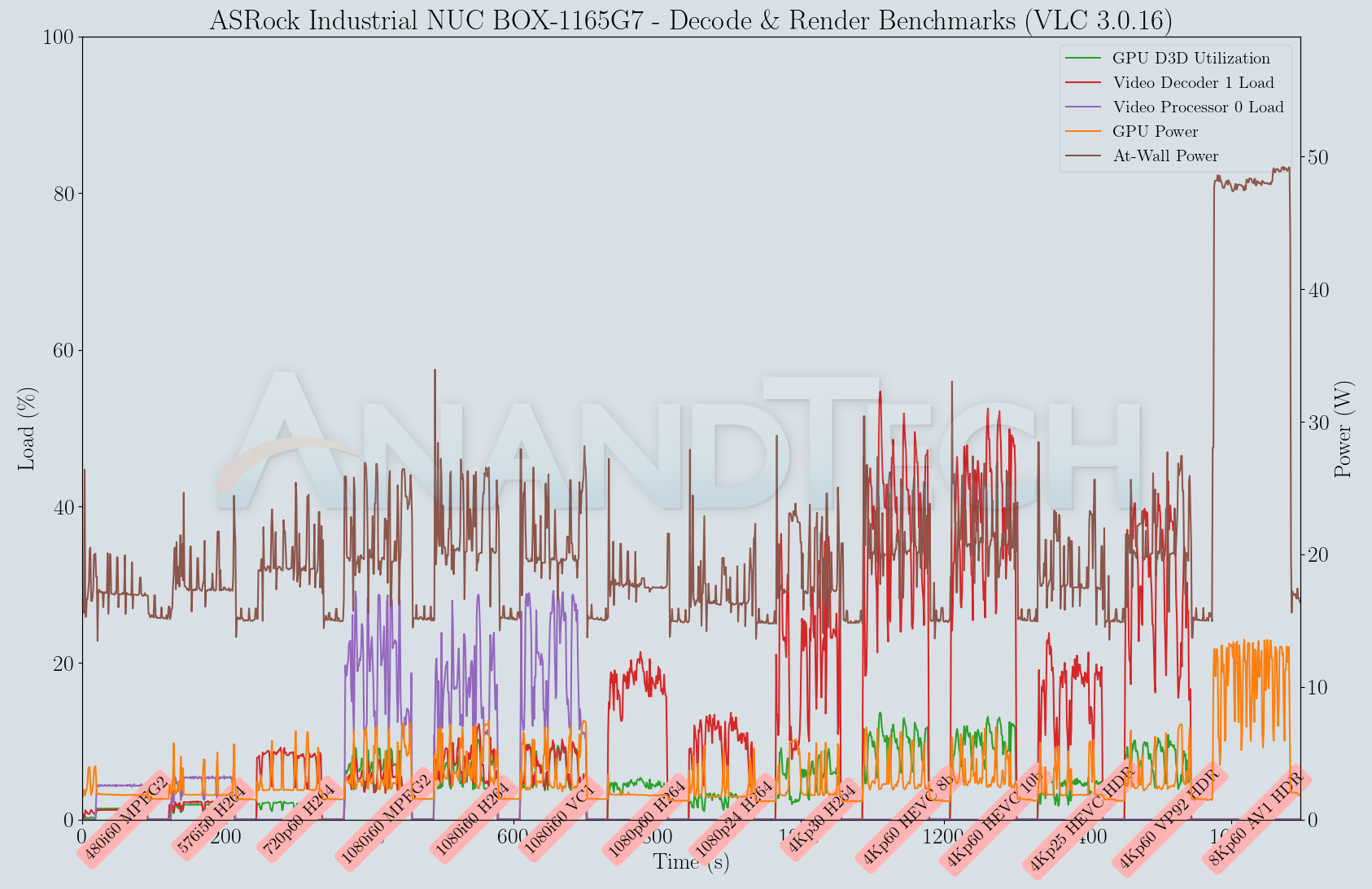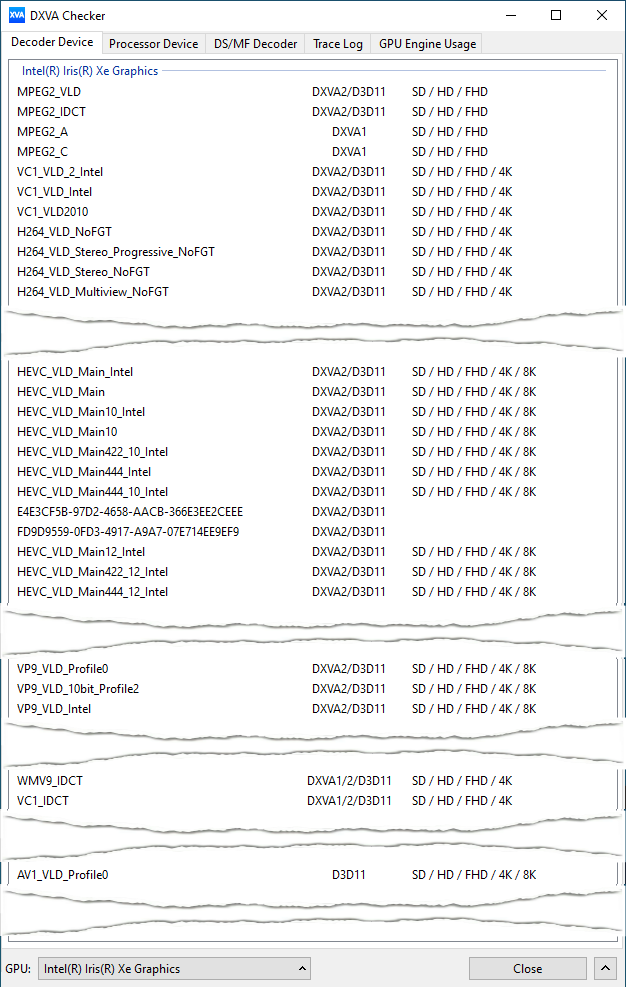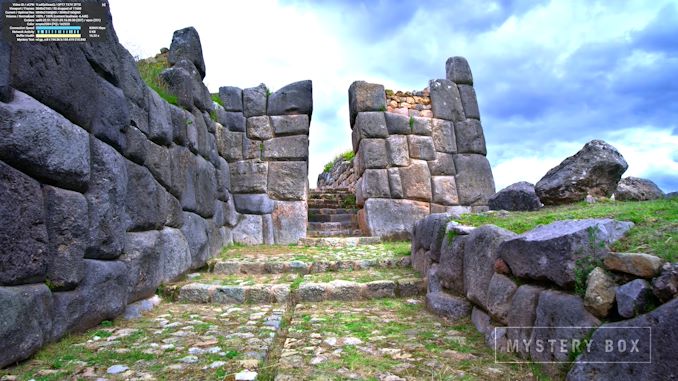ASRock Industrial NUC BOX-1165G7 Mini-PC Review: An Ultra-Compact Tiger Lake Desktop
by Ganesh T S on August 26, 2021 8:15 AM EST- Posted in
- Systems
- Intel
- NUC
- UCFF
- Willow Cove
- ASRock Industrial
- Tiger Lake-U
HTPC Workloads
Media playback and video post-processing without taxing the CPU are some of the functionalities that have been relegated to GPUs over the 10 - 15 years. The transitions to higher video resolutions and complicated video codecs have become more frequent. While the move from SD (480p) to HD (720p) took the better part of the 2000s, the transition to FHD (1080p), 4K (2160p), and now 8K (4320p) have all happened in the last decade. The rise of over-the-top (OTT) delivery platforms like YouTube, Netflix, etc. have accelerated the development and deployment of new codecs and higher resolution videos.
On Windows, GPUs expose their video decoding and post-processing capabilities via DXVA / D3D11 APIs. The DXVAChecker program provides a quick overview of the GPU features related to these aspects. All major modern codecs (including AV1) are supported for decoding across multiple resolutions. Support for decoding 4:2:2 and 4:4:4 videos is unique to Intel's hardware decoder, though it is unlikely for the NUC BOX-1165G7 to be used for processing such streams.
Windows has adopted an on-demand delivery of OS components for activating the usage of these APIs. Similar to the MS Store HEVC codec, the AV1 codec is also being delivered via the MS store. While open-source programs like MPC-HC can use the AV1 decoding capabilities of the GPU using the LAV Filters component, AV1 decoding with MS Edge requires the installation of the extension.
YouTube Streaming
The move to 4K and 8K, and the need to evaluate HDR support have made us choose Mystery Box's Peru 8K HDR 60FPS video as our test sample moving forward. On PCs running Windows, it is recommended that HDR streaming videos be viewed using the Microsoft Edge browser after putting the desktop in HDR mode.
Without installing the AV1 extension, the VP9 Profile 2 4K version is played back as shown above. However, installing the extension allows flawless playback of the 8K version, as shown in the screenshot below.
Various metrics of interest such as GPU usage and at-wall power consumption were recorded for the first four minutes of the playback of the above video in both modes (VP9 Profile 2, and AV1). The numbers are graphed below.
| YouTube Streaming Efficiency - 4Kp60 VP9.2 and 8Kp60 AV1 | |||

The playback of the 4K stream is flawless. The 8K stream, despite saturating the decoder for most of the time, did manage to play back without dropped frames except when the overlay was activated. The playback is not particularly power efficient, with the 4K stream consuming around 25W at the wall, and the 8K decode / 4K display consuming around 38W.
Evaluation of local media playback and video processing is done by playing back files encompassing a range of relevant codecs, containers, resolutions, and frame rates. A note of the efficiency is also made by tracking GPU usage and power consumption of the system at the wall. Users have their own preference for the playback software / decoder / renderer, and our aim is to have numbers representative of commonly encountered scenarios. Towards this, we played back the test streams using the following combinations:
- MPC-HC x64 1.9.14 + LAV Video Decoder (DXVA2 Native) + Enhanced Video Renderer - Custom Presenter (EVR-CP)
- MPC-HC x64 1.9.14 + LAV Video Decoder (D3D11) + madVR 0.92.17 (DXVA-Focused)
- VLC 3.0.16
- Kodi 19.1
Fourteen test streams comprising of various codecs and frame rates (each of 90s duration) were played back from the local disk with an interval of 30 seconds in-between. Various metrics including GPU usage and at-wall power consumption were recorded during the course of this playback.
All our playback tests were done with the desktop HDR setting turned on. It is possible for certain system configurations to have madVR automatically turn on/off the HDR capabilities prior to the playback of a HDR video, but, we didn't take advantage of that in our testing.
VLC and Kodi
VLC is the playback software of choice for the average PC user who doesn't need a ten-foot UI. Its install-and-play simplicity has made it extremely popular. Over the years, the software has gained the ability to take advantage of various hardware acceleration options. Kodi, on the other hand, has a ten-foot UI making it the perfect open-source software for dedicated HTPCs. Support for add-ons make it very extensible and capable of customization. We played back our test files using the default VLC and Kodi configurations, and recorded the following metrics.
| Video Playback Efficiency - VLC and Kodi | |||

Both VLC and Kodi perform software decoding for the 8Kp60 AV1 stream. The Core i7-1165G7 is simply unable to keep up with the requirements, resulting in a slideshow of sorts. Other codecs present no challenge to the system, with hardware-accelerated decode ensuring power consumption remains modest at around 20 - 25 W.
MPC-HC
MPC-HC offers an easy way to test out different combinations of decoders and renderers. The first configuration we evaluated is the default post-install scenario, with only the in-built LAV Video Decoder forced to DXVA2 Native mode. One additional pass was done with madVR configured to make use of the DXVA-accelerated video processing capabilities as much as possible. The metrics collected during the playback of the test files using the above three configurations are presented below.
| Video Playback Efficiency - MPC-HC with EVR-CP and madVR | |

The LAV Filters integrated in MPC-HC 1.9.14 is able to successfully play back the 8Kp60 AV1 stream with hardware acceleration. In fact, the decoder load is much lesser compared to playing back the stream using the MS Edge browser. On the flop side, the average power consumption at the wall is a tad higher compared to playing back the same streams with Kodi. The madVR (DXVA) configuration also surprisingly played back almost all the streams without frame drops.













33 Comments
View All Comments
TheinsanegamerN - Thursday, August 26, 2021 - link
Really dissapointed there are no games benchmarked." If AMD's OEMs manage to create a mini-PC with, say, the Ryzen 7 5800U in a 25W cTDP-up configuration, Tiger Lake-U's appeal could be dented further."
Well that's just not going to happen. Even now 4700/4800u NUC sized PCs are extremely rare, and AMD isnt going to bother making their own.
xsoft7 - Thursday, August 26, 2021 - link
there is a Zen3 mini PC.. with 5900HXhttps://store.minisforum.com/collections/all-produ...
TheinsanegamerN - Friday, August 27, 2021 - link
Now that's interesting. Not a single tech outlet has talked about these guys yet.ganeshts - Friday, August 27, 2021 - link
Coverage dated Aug. 4th: https://www.anandtech.com/show/16866/minisforum-un...TheinsanegamerN - Tuesday, September 7, 2021 - link
That's nothing more then a product announcement. It's not a review, and if we base a products coverage by announcements then there are 15 electric trucks on the market already.meacupla - Thursday, August 26, 2021 - link
By "rare", do you mean product variety, or product availability?Because I can totally find the 4x4 BOX-4800U in stock, at newegg. They even have a BRIX with 4800U in stock.
Of course, if you are outside of NA, then GL with that.
domih - Thursday, August 26, 2021 - link
4x4 BOX-4800U user here in California. I bought it on NewEgg months ago, then it became out of stock, then apparently NewEgg is expecting a new batch. Good news for you guys: it is even less expensive now. Experience matches this review. Yes, the 4800U model has DASH allowing out-of-band management. The box is so small that some wide USB keys won't coexist pacifically with others. Ubuntu 20.04. When I ran Phoronix tests the box went quite hot and the fan is not really silent. Should be OK as HTPC though, won't get that hot playing video.ifThenError - Friday, August 27, 2021 - link
>> Well that's just not going to happen.Well not quite so fortunately! Gigabyte has anounced a UCFF barebone going up to a Ryzen 7 5800u to be released in "available in Q3 2021".
https://www.gigabyte.com/Press/News/1915
In theory you could order one within the next 1 - 2 months, if and when you can really purchase these, we will see...
quiksilvr - Friday, August 27, 2021 - link
More disappointed that upon looking at the gallery it is two USB-C ports and not a Thunderbolt 4 port on the device.ginandbacon - Sunday, October 10, 2021 - link
I own this device, you have to install a TB driver and I have a TB4 Hub attached with two TB3 NVME drives and they both work at TB3 speeds (40Gbps), Asrock didn't want to pay Intel, I bet Asrock gets sued over this. You can find the board on Ebay for around $260 if you are willing to wait, it's the better deal, the case is junk anyways. I was under the impression that both front USB C ports where TB4 but Asrock hinted they were and only one is.